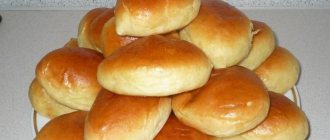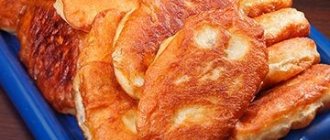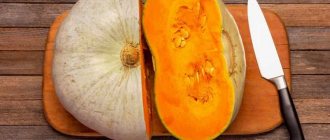Calorie content of pies
What do most of us associate pies with? With a happy childhood, holidays with my grandmother in the village and a lot of memorable and definitely pleasant moments.
Pies occupy one of the main places among traditional dishes of Russian cuisine. This is an indispensable attribute of festive feasts and a frequent guest at the everyday table. Pies are a high-calorie dish, but despite this, they remain popular even in an era of universal desire for slimness. Hearty, aromatic and tasty - the pies will not leave indifferent even the most persistent “fighters” with excess calories.
How calorie-rich the pies will be depends on several factors:
- what dough they are made from and what flour was used as a basis;
- how they were prepared;
- what is included in the filling.
The dough for pies can be very diverse: yeast and puff pastry, mixed with kefir or water. Yeast pies are much higher in calories than those made from yeast-free dough. Products made from wheat flour have the highest energy value compared to analogues made from rye, oatmeal or any other flour.
There are two ways to prepare pies: they can be baked or fried. Baked pies are lower in calories. Fried dough products add to their considerable calorie content the calorie content of the oil that was used for frying.
The filling for pies can be as different as the housewife’s imagination allows: potatoes and cabbage, meat and mushrooms, cottage cheese and jam. The pies are sweet and salty, with simple and combined fillings – you can’t list everything.
If we compare the calorie content of the filling, then using cabbage for it will allow you to prepare lower-calorie pies compared to potato filling, which have lower energy value than any type of sweet pies.
Do you pay attention to your diet and don’t need extra calories, but still want to pamper yourself and your family with pies? Opt for baked pies with cabbage.
The calorie content of 100 grams of cabbage pies prepared according to the following recipe is 175 kcal.
How to cook them? There are no special secrets here.
To prepare the dough you will need:
- wheat flour – 1 kg;
- water – 400 ml;
- vegetable oil – 70 ml;
- dry yeast – 10 grams;
- salt – 2 teaspoons;
- sugar – 2 tablespoons.
Yeast is diluted with warm water. As soon as they “disperse”, the remaining ingredients are added and a soft dough is kneaded. While it is “coming up”, it’s time to start filling.
For the filling we need cabbage and onions. The onion is finely chopped and sautéed in a frying pan in vegetable oil. The cabbage is chopped and added to the onion. Salt and pepper the future filling and simmer under the lid until ready.
Our dough is “right”, the filling is ready - it’s time to start shaping the pies. The prepared pies must be placed on a baking sheet and left for 10-15 minutes, after which they can be placed in an oven preheated to 180 degrees. Baking time for pies is 15-20 minutes.
By replacing fresh cabbage with sauerkraut in the pie filling, the calorie content can be significantly reduced.
The energy value of baked pies with sauerkraut is 129 kcal per 100 grams of product.
Dishes for weight loss, recipes for all occasions
Mobile app
Download our free daily calorie counting app with built-in calorie chart!
Nutritional value and chemical composition of “Fried pie with meat.”
| Nutrient | Quantity | Norm** | % of the norm in 100 g | % of the norm in 100 kcal | 100% normal |
| Calorie content | 289 kcal | 1684 kcal | 17.2% | 6% | 583 g |
| Squirrels | 4.7 g | 76 g | 6.2% | 2.1% | 1617 g |
| Fats | 8.8 g | 56 g | 15.7% | 5.4% | 636 g |
| Carbohydrates | 47.8 g | 219 g | 21.8% | 7.5% | 458 g |
The energy value of a fried pie with meat is 289 kcal.
Primary Source: Created in the application by the user. Read more.
** This table shows the average levels of vitamins and minerals for an adult. If you want to know the norms taking into account your gender, age and other factors, then use the “My Healthy Diet” application.
How to cook the dish “Meat Pies”
- Pre-fry the minced pork with spices for 15 minutes.
- Roll out the dough and cut into squares.
- Place the filling in the middle of each square and fold into an envelope.
- Place the pies on a greased baking sheet.
- Bake for 30 minutes at 180 degrees.
- Puff pastry - 500 gr.
- Minced pork - 500 gr.
- Salt (to taste) - 2 gr.
- Black pepper (to taste) - 2 gr.
- Vegetable oil - 2 tbsp.
Nutritional value of the dish “Meat Pies” (per 100 grams):
One of the most popular dishes using flour is pies stuffed with cabbage and potatoes. They are usually baked or fried using yeast dough as a base. How many calories are in a pie? Can this product be combined with a low calorie diet?
- Calorie content of fried cutlets
- Fried potatoes, benefits, harm and calorie content
- Diet menu "Lesenka"
- Calorie table for all foods
Calorie content of pies with potatoes
Potato pies are in great demand. But the calorie content of potato pies cannot be called low, since it is 300 kcal per hundred grams of product. We are talking here about a baked pie with potatoes. If we talk about the fried form, then in this case, the calorie content of pies with potatoes will be several times higher. Here the calorie content is determined by the type of dough.
Depending on the type of dough, the calorie content in potato pies will increase or decrease. Butter dough made with milk and eggs is much more nutritious than simple dough made with water. In addition, it is best to bake pies in the oven - in this case there will be fewer carcinogens and calories.
How many eggs can you eat?
After lengthy discussions on the benefits and harms of eggs, experts from various fields of science agreed that moderate consumption does not cause any harm to humans. But their absence in the diet can seriously affect your health. After all, this is a storehouse of useful substances that are necessary for a person of any age. The exception is individual contraindications (for example, allergies).
- People with excess cholesterol in the blood can consume no more than three eggs per week.
- People who have normal blood cholesterol levels can eat one egg per day, or 5-7 eggs per week. It is not recommended to exceed this norm, since they are also contained in other products (for example, baked goods or cutlets).
- If the child does not have allergies, then you can give him eggs starting from the age of 8–12 months. You should start with one yolk per week. It is forbidden to give protein, as it can cause diathesis in a child.
- At the age of 1–1.5 years, a child can be given one per week.
- Children aged 2–3 years can eat no more than three eggs per week.
- From 4 to 6 years old - no more than five per week.
Calorie content of egg pie
Speaking about the calorie content of a pie with an egg, one cannot help but say that it also depends on the type of dough. But you can reduce the calorie content of the egg pie by using low-fat milk and durum wheat flour for the dough.
It should also be said that the calorie content of a pie with an egg fried in a frying pan will be several times higher than the calorie content of a pie with an egg baked in the oven. Thus, the calorie content of a baked pie is only 240 kcal per hundred grams of product, and the calorie content of a fried pie in a frying pan is 340 kcal per hundred grams of product. As you can see, the difference in calories is large.
Calorie content of baked pies (per 100 g):
- Calorie content of pies with cabbage - 214 kcal
- Calorie content of pies with potatoes - 235 kcal
- Calorie content of pies with egg - 204 kcal
- Calorie content of meat pies - 256 kcal
- Calorie content of pies with mushrooms - 192 kcal
- Calorie content of fish pies - 180 kcal
- Calorie content of apple pies - 177 kcal
- Calorie content of pies with cottage cheese - 209 kcal
- Calorie content of pies with jam - 240 kcal
Calorie content of fried pies (per 100 g):
- Calorie content of pies with cabbage - 263 kcal
- Calorie content of pies with potatoes - 276 kcal
- Calorie content of pies with egg - 260 kcal
- Calorie content of meat pies - 342 kcal
- Calorie content of pies with mushrooms -226 kcal
- Calorie content of fish pies - 215 kcal
- Calorie content of apple pies - 205 kcal
- Calorie content of pies with cottage cheese - 217 kcal
- Calorie content of pies with jam - 289 kcal
Calorie content of cutlets from various types of meat
Properties of pies
Few people write about the benefits of fried foods, because there is nothing to write about. The same is true with pies fried in a large amount of oil. Due to the oxidation of fats, free radicals appear, which provoke the development of atherosclerosis and all kinds of cardiovascular diseases. Carcinogens evaporating from burning oil (heated many times) cause cancer.
Also, excessively fatty fried foods have a detrimental effect on the gastrointestinal tract and well-being in general, causing a feeling of heaviness, and “hits” the liver.
But if you replace frying with baking in the oven, then everything will change dramatically. “Correct” carbohydrates, broken down during the fermentation process, saturate the body with the necessary energy, yeast sticks normalize digestion, forming beneficial microflora in the intestines. Nutrients help increase the body's resistance and immunity. Moreover, baked pies help eliminate carcinogens and toxins. It is an excellent source of calories for children and workers with heavy physical activities. The benefits of baked pies are further enhanced by various fillings: meat, fish, berries, vegetables, herbs, boiled eggs, mushrooms, etc.
The nutritional value
A chicken egg contains 12.7 g of protein, 10.9 g of fat and 0.7 g of carbohydrates (per 100 g of product). In a hard-boiled one weighing about 60 g, the amount of proteins, fats and carbohydrates is approximately the following: proteins - 7.8 g, fats - 7.2 g, carbohydrates - 0.6 g. They contain 12 vitamins.
- Vitamin A is necessary for the formation of teeth and the skeletal system, has a beneficial effect on vision, stimulates fat metabolism and the growth of new cells, slows down the aging process, prevents inflammatory processes and diseases of the cardiovascular system.
- B6 – accelerates metabolism, relieves excitement in the central nervous system, ensures the formation of energy from carbohydrates, creates the necessary conditions for the synthesis of hemoglobin, and participates in the synthesis of insulin.
- B12 – promotes the development of red blood cells, improves heart health, stimulates metabolism, fat metabolism in liver tissue, and reduces cholesterol levels.
- E – is an antioxidant, improves oxygen transport to tissues, prevents the formation of blood clots, improves nutrition of the skin and mucous membranes.
- D – ensures normal development of bones and teeth, enhances the functioning of the immune system, stimulates the functioning of the thyroid gland.
- Folic acid – participates in DNA synthesis, ensures the normal formation of immunity, stimulates the functioning of the gastrointestinal tract.
- Riboflavin is necessary for the formation of hormones and red blood cells, protects the retina from exposure to ultraviolet rays, participates in the breakdown of proteins, fats and carbohydrates, and ensures tissue renewal.
- Niacin – participates in redox processes, tissue respiration, carbohydrate and protein metabolism, stimulates the secretion of gastric juice.
- Thiamine – participates in the metabolism of proteins, fats and carbohydrates, stimulates the functioning of the cardiovascular, nervous and digestive systems.
- Choline – participates in fat and cholesterol metabolism, ensures the normal functioning of the nervous system, destroys cholesterol plaques on the walls of blood vessels, and reduces blood sugar levels.
- Biotin – is involved in the synthesis of hemoglobin and in the processing of glucose, regulates blood sugar levels, promotes fat burning in the body, and normalizes the activity of the sebaceous glands.
- Pantothenic acid – participates in the formation of antibodies, prevents inflammatory processes, promotes fat burning.
Correct usage
You need to eat pies wisely, keeping in mind some rules:
- Pies contain a large amount of carbohydrates. During the day, these carbohydrates are digested and spent during your activity. If a large amount of them enters the body after 18 hours (in the form of a pie eaten at night), then they will be converted into adipose tissue.
- For the filling, choose fresh natural vegetables or lean meat - chicken or turkey. For sweet pies, low-fat cottage cheese is a good filling option.
- The dough tends to stick together and interfere with the passage of food through the intestines. Therefore, after eating the pies, it is advisable to make the next meal light and, if possible, include a liquid dish in it.
Combination of pies with the diet menu
Why don’t nutritionists recommend regularly including a pie with potatoes or cabbage on the menu? The main harm is caused not by the calorie content of the product, but by the high content of simple carbohydrates. Simple carbohydrates quickly penetrate the blood. They are absorbed much faster than the body receives energy from them. As a result, the sugar level rises sharply and an insulin reaction begins. The process leads to fat accumulation.
How to combine eating pie with losing weight? When losing weight, it is recommended to temporarily exclude the dish from the diet, but at the stage of maintaining body weight, it is not forbidden to eat this tasty product on rare occasions.
The basic rule is that flour-based products must be cooked in the oven; fried foods are not compatible with dietary nutrition.
How to eat pies correctly while following a diet?
- You should not snack on cabbage or potato pie in the evening. In this case, all calories and carbohydrates will go to the stomach and thighs.
- You can eat the pie for breakfast or as a snack before lunch. The main time to have a snack with this dish is before 14.00.
- The number of pies should not exceed more than one.
- Preference is best given to a lean baked pie with cabbage. It has fewer calories than the same product with potatoes.
To reduce the calorie content of flour dishes with potatoes or cabbage, you should cook them at home. The use of yeast-free unleavened dough is good for diet. You can use low-fat milk, olive oil, and wholemeal flour in the recipe. Store-bought products often contain margarine or palm oil.
And a little about secrets.
The story of one of our readers, Inga Eremina:
I was especially depressed by my weight; at 41, I weighed as much as 3 sumo wrestlers combined, namely 92 kg. How to completely lose excess weight? How to cope with hormonal changes and obesity? But nothing disfigures or makes a person look younger than his figure.
But what can you do to lose weight? Laser liposuction surgery? I found out - no less than 5 thousand dollars. Hardware procedures - LPG massage, cavitation, RF lifting, myostimulation? A little more affordable - the course costs from 80 thousand rubles with a nutritionist consultant. You can, of course, try to run on a treadmill until you go crazy.
And when will you find time for all this? And it's still very expensive. Especially now. Therefore, I chose a different method for myself.
Source










